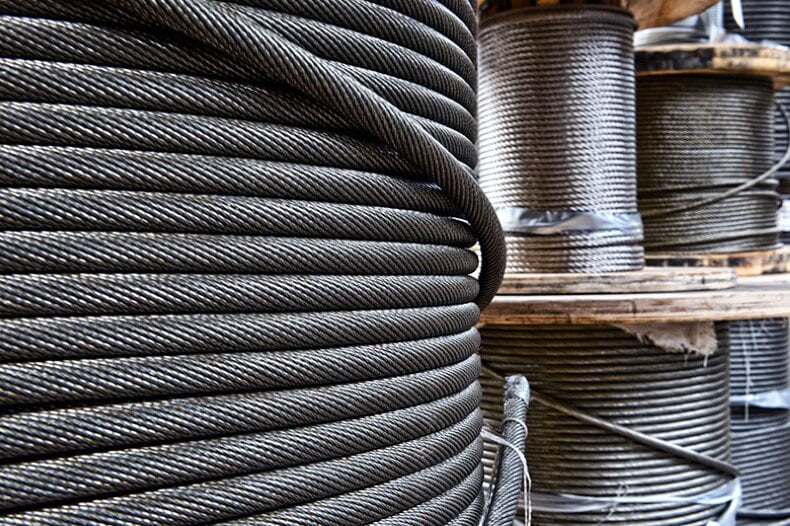A Comprehensive Guide to the Use of Wire Rope in the Oil and Gas Industry
Wire ropes are a cornerstone of the oil and gas industry, providing strength, reliability, and safety in some of the most demanding environments. These versatile tools are used extensively in lifting, pulling, and securing operations, making them indispensable to offshore platforms, drilling rigs, and other critical infrastructure. In this guide, we’ll explore the applications, benefits, and best practices for wire ropes in the oil and gas sector.
What Is Wire Rope?
Wire rope is a robust assembly of steel wires twisted into strands and helically wound around a core to form a strong and flexible structure. Its design ensures durability and high tensile strength, making it ideal for heavy-duty applications in the oil and gas industry.
Applications of Wire Rope in the Oil and Gas Industry
Wire ropes are utilized across various stages of oil and gas operations, including:
-
Drilling Operations
- Description: Used in hoisting systems to lift and lower drill pipes, casings, and other heavy equipment.
- Benefits: High load-bearing capacity and resistance to abrasion.
-
Marine and Offshore Operations
- Description: Essential for mooring vessels, anchoring platforms, and handling subsea equipment.
- Benefits: Corrosion-resistant coatings and superior performance in harsh marine environments.
-
Rigging and Lifting
- Description: Employed in cranes, winches, and other lifting equipment to move heavy loads.
- Benefits: Flexibility and reliability under high-stress conditions.
-
Pipeline Installation
- Description: Used for pulling and positioning large sections of pipelines during installation.
- Benefits: Strong enough to handle extreme tension without compromising integrity.
-
Emergency Operations
- Description: Deployed in rescue missions and emergency load handling.
- Benefits: Quick deployment and robust construction.
Types of Wire Rope Used in the Oil and Gas Industry
Wire ropes come in various designs to meet specific requirements. Here are some commonly used types:
-
EIPS (Extra Improved Plowed Steel)
- Features: Higher tensile strength for heavy-duty applications.
- Applications: Hoisting and towing operations.
-
IWRC (Independent Wire Rope Core)
- Features: A core made of wire strands for added strength and flexibility.
- Applications: High-load lifting and drilling operations.
-
Galvanized Wire Rope
- Features: Coated with zinc to resist corrosion.
- Applications: Offshore and marine environments.
-
Stainless Steel Wire Rope
- Features: High corrosion resistance and durability.
- Applications: Subsea and long-term outdoor use.
Benefits of Wire Rope in the Oil and Gas Industry
- High Strength: Capable of handling extreme loads without deformation.
- Durability: Resistant to wear, corrosion, and fatigue, ensuring longevity.
- Versatility: Suitable for a wide range of applications, from drilling to marine operations.
- Safety: Designed to withstand sudden stress and tension, minimizing the risk of failure.
- Cost-Effective: Long service life reduces the need for frequent replacements.
Best Practices for Using Wire Rope
To ensure optimal performance and safety, follow these best practices:
- Regular Inspections: Check for wear, corrosion, or broken wires to prevent failures.
- Proper Lubrication: Use appropriate lubricants to reduce friction and extend lifespan.
- Correct Installation: Ensure proper alignment and tensioning during installation.
- Load Monitoring: Avoid exceeding the wire rope’s load capacity.
- Training: Provide operators with adequate training on handling and maintenance.
Maintenance Tips for Wire Rope
- Clean Regularly: Remove dirt, salt, and debris to prevent corrosion.
- Store Properly: Keep wire ropes in a dry, covered area away from harsh elements.
- Replace Worn Ropes: Immediately replace any ropes showing significant wear or damage.
- Document Inspections: Maintain records of inspections and maintenance activities.
Conclusion
Wire ropes play a vital role in the oil and gas industry, offering unmatched strength, durability, and versatility for various operations. By understanding their applications, benefits, and maintenance requirements, you can ensure optimal performance and safety in your projects.
Invest in high-quality wire ropes and rely on trusted suppliers to meet the rigorous demands of the oil and gas sector. For expert guidance or to explore a wide range of wire rope solutions, contact our team of professionals today.
.png)












